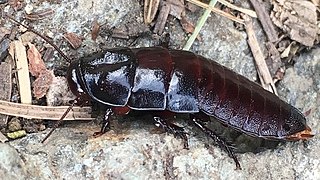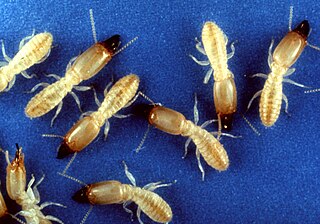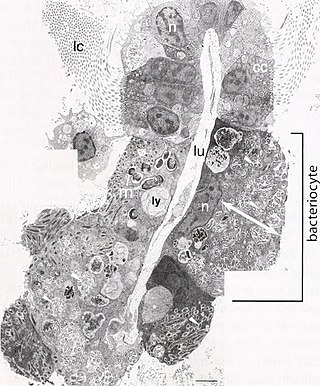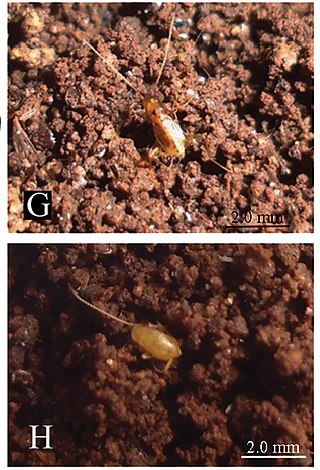Related Research Articles

An endosymbiont or endobiont is any organism that lives within the body or cells of another organism most often, though not always, in a mutualistic relationship. (The term endosymbiosis is from the Greek: ἔνδον endon "within", σύν syn "together" and βίωσις biosis "living".) Examples are nitrogen-fixing bacteria, which live in the root nodules of legumes, single-cell algae inside reef-building corals and bacterial endosymbionts that provide essential nutrients to insects.

Termites are a group of detritophagous eusocial insects which consume a wide variety of decaying plant material, generally in the form of wood, leaf litter, and soil humus. They are distinguished by their moniliform antennae and the soft-bodied and often unpigmented worker caste for which they have been commonly termed "white ants"; however, they are not ants, to which they are distantly related. About 2,972 extant species are currently described, 2,105 of which are members of the family Termitidae.

Trophallaxis is the transfer of food or other fluids among members of a community through mouth-to-mouth (stomodeal) or anus-to-mouth (proctodeal) feeding. Along with nutrients, trophallaxis can involve the transfer of molecules such as pheromones, organisms such as symbionts, and information to serve as a form of communication. Trophallaxis is used by some birds, gray wolves, vampire bats, and is most highly developed in eusocial insects such as ants, wasps, bees, and termites.

Dictyoptera is an insect superorder that includes two extant orders of polyneopterous insects: the order Blattodea and the order Mantodea (mantises). All modern Dictyoptera have short ovipositors and typically lay oothecae. The oldest fossils of Dictyoptera from the Late Carboniferous, referred to as "roachoids" have long ovipositors and did not lay oothecae. The oldest modern oothecae-laying dictyopterans date to the Late Triassic.

Cryptocercus is a genus of Dictyoptera and the sole member of its own family Cryptocercidae. Species are known as wood roaches or brown-hooded cockroaches. These roaches are subsocial, their young requiring considerable parental interaction. They also share wood-digesting gut bacteria types with wood-eating termites, and are therefore seen as evidence of a close genetic relationship, that termites are essentially evolved from social cockroaches.

Blattodea is an order of insects that contains cockroaches and termites. Formerly, termites were considered a separate order, Isoptera, but genetic and molecular evidence suggests they evolved from within the cockroach lineage, cladistically making them cockroaches as well. The Blattodea and the mantis are now all considered part of the superorder Dictyoptera. Blattodea includes approximately 4,400 species of cockroach in almost 500 genera, and about 3,000 species of termite in around 300 genera.

Cockroaches are insects belonging to the order Blattodea (Blattaria). About 30 cockroach species out of 4,600 are associated with human habitats. Some species are well-known as pests.

Reticulitermes flavipes, the eastern subterranean termite, is the most common termite found in North America. These termites are the most economically important wood destroying insects in the United States and are classified as pests. They feed on cellulose material such as the structural wood in buildings, wooden fixtures, paper, books, and cotton. A mature colony can range from 20,000 workers to as high as 5 million workers and the primary queen of the colony lays 5,000 to 10,000 eggs per year to add to this total.

A bacteriocyte, also known as a mycetocyte, is a specialized adipocyte found primarily in certain insect groups such as aphids, tsetse flies, German cockroaches, weevils. These cells contain endosymbiotic organisms such as bacteria and fungi, which provide essential amino acids and other chemicals to their host. Bacteriocytes may aggregate into a specialized organ called the bacteriome.
Symbiotic bacteria are bacteria living in symbiosis with another organism or each other. For example, rhizobia living in root nodules of legumes provide nitrogen fixing activity for these plants.

Xylophagy is a term used in ecology to describe the habits of an herbivorous animal whose diet consists primarily of wood. The word derives from Greek ξυλοφάγος (xulophagos) "eating wood", from ξύλον "wood" and φαγεῖν "to eat", an ancient Greek name for a kind of a worm-eating bird. Animals feeding only on dead wood are called sapro-xylophagous or saproxylic.

Blaberus giganteus, the Central American giant cave cockroach or Brazilian cockroach, is a cockroach belonging to the family Blaberidae. One of the world's largest cockroaches, it is native to the warm parts of the Neotropical realm.

Trichonympha is a genus of single-celled, anaerobic parabasalids of the order Hypermastigia that is found exclusively in the hindgut of lower termites and wood roaches. Trichonympha’s bell shape and thousands of flagella make it an easily recognizable cell. The symbiosis between lower termites/wood roaches and Trichonympha is highly beneficial to both parties: Trichonympha helps its host digest cellulose and in return receives a constant supply of food and shelter. Trichonympha also has a variety of bacterial symbionts that are involved in sugar metabolism and nitrogen fixation.

Mastotermes darwiniensis, common names giant northern termite and Darwin termite, is a termite species found only in northern Australia. It is the most primitive extant termite species. Contrary to common belief, this species does not form mounds as the nests are subterranean and inconspicuous. Colonies will readily occupy and infest decomposing wood but primarily live in a complex subterranean network of tunnels and galleries which they use to travel to new food sites. Colonies may eventually split and form isolated satellite colonies.

Therea petiveriana, variously called the desert cockroach, seven-spotted cockroach, or Indian domino cockroach, is a species of crepuscular cockroach found in southern India. They are members of a basal group within the cockroaches. This somewhat roundish and contrastingly marked cockroach is mainly found on the ground in scrub forest habitats where they may burrow under leaf litter or loose soil during the heat of the day.

Nocticola is a genus of cockroaches in the family Nocticolidae distributed in Africa, south-east Asia and Australia. Nocticola are different from every other cockroach in that they are not infected with Blattabacterium cuenoti. This makes them the only genus in Blattodea that do not have the bacteria.
Sodalis is a genus of bacteria within the family Pectobacteriaceae. This genus contains several insect endosymbionts and also a free-living group. It is studied due to its potential use in the biological control of the tsetse fly. Sodalis is an important model for evolutionary biologists because of its nascent endosymbiosis with insects.

Diploptera punctata, the Pacific beetle cockroach, is a species of cockroach in the family Blaberidae and subfamily Diplopterinae. It is one of the few cockroach species that is viviparous. Adults are chemically defended, having a modified tracheal gland and spiracle on each side which squirts quinones which can poison or discourage a predator.

Cryptocercus punctulatus, known generally as brown-hooded cockroach, is a species of cockroach in the family Cryptocercidae. Other common names include the woodroach, wingless wood roach, and eastern wood-eating cockroach. It is found in North America.

The Morganellaceae are a family of Gram-negative bacteria that include some important human pathogens formerly classified as Enterobacteriaceae. This family is a member of the order Enterobacterales in the class Gammaproteobacteria of the phylum Pseudomonadota. Genera in this family include the type genus Morganella, along with Arsenophonus, Cosenzaea, Moellerella, Photorhabdus, Proteus, Providencia and Xenorhabdus.
References
- ↑ Kambhampati S (2010). "Family II. Blattabacteriaceae fam. nov.". In Krieg NR, Staley JT, Brown DR, Hedlund BP, Paster BJ, Ward NL, Ludwig W, Whitman WB (eds.). Bergey's Manual of Systematic Bacteriology. Vol. 4 (2nd ed.). New York, NY: Springer. p. 315.
- ↑ Hollande AC, Favre R (1931). "La structure cytologique de Blattabacterium cuenoti (Mercier) N.G., symbiote du tissu adipeux des Blattides". Comptes Rendus des Séances de la Société de Biologie (Paris). 107: 752–754.
- ↑ Lo N, Beninati T, Stone F, Walker J, Sacchi L (June 2007). "Cockroaches that lack Blattabacterium endosymbionts: the phylogenetically divergent genus Nocticola". Biology Letters. 3 (3): 327–330. doi:10.1098/rsbl.2006.0614. PMC 2464682 . PMID 17376757.
- ↑ Zuckerman W (16 April 2011). "The secret superpower of the cockroach". New Scientist .
- ↑ Lo N, Eggleton P (2011). "Termite Phylogenetics and Co-cladogenesis with Symbionts". In Bignell D, Roisin Y, Lo N (eds.). Biology of Termites: A Modern Synthesis. pp. 27–50. doi:10.1007/978-90-481-3977-4_2.
- ↑ Clark JW, Kambhampati S (January 2003). "Phylogenetic analysis of Blattabacterium, endosymbiotic bacteria from the wood roach, Cryptocercus (Blattodea: Cryptocercidae), including a description of three new species". Molecular Phylogenetics and Evolution. 26 (1): 82–88. doi:10.1016/S1055-7903(02)00330-5. PMID 12470940.
- ↑ Boone DR, Castenholz RW, eds. (2001). Bergey's Manual of Systematic Bacteriology. Volume 1. The Archaea and the deeply branching and phototrophic Bacteria (2nd ed.). New York: Springer-Verlag. pp. 465–466. ISBN 978-0-387-98771-2.
- ↑ Patiño-Navarrete R, Moya A, Latorre A, Peretó J (2013). "Comparative genomics of Blattabacterium cuenoti: the frozen legacy of an ancient endosymbiont genome". Genome Biology and Evolution. 5 (2): 351–361. doi:10.1093/gbe/evt011. PMC 3590773 . PMID 23355305.
- 1 2 "Blattabacterium Tree". Genome Taxonomy Database (GTDB). The University of Queensland. Retrieved 20 December 2022.
- ↑ Sabree ZL, Kambhampati S, Moran NA (November 2009). "Nitrogen recycling and nutritional provisioning by Blattabacterium, the cockroach endosymbiont". Proceedings of the National Academy of Sciences of the United States of America. 106 (46): 19521–19526. Bibcode:2009PNAS..10619521S. doi: 10.1073/pnas.0907504106 . PMC 2780778 . PMID 19880743.
- ↑ Patiño-Navarrete R, Piulachs MD, Belles X, Moya A, Latorre A, Peretó J (July 2014). "The cockroach Blattella germanica obtains nitrogen from uric acid through a metabolic pathway shared with its bacterial endosymbiont". Biology Letters. 10 (7): 7. doi:10.1098/rsbl.2014.0407. PMC 4126632 . PMID 25079497.
- ↑ Carrasco P, Pérez-Cobas AE, van de Pol C, Baixeras J, Moya A, Latorre A (June 2014). "Succession of the gut microbiota in the cockroach Blattella germanica". International Microbiology. 17 (2): 99–109. doi:10.2436/20.1501.01.212. PMID 26418854.
- ↑ Jahnes BC, Sabree ZL (June 2020). "Nutritional symbiosis and ecology of host-gut microbe systems in the Blattodea". Current Opinion in Insect Science. Pests and resistance * Behavioural ecology. 39: 35–41. doi: 10.1016/j.cois.2020.01.001 . PMID 32109859. S2CID 211565307.
- ↑ Engelstädter J, Hurst GD (December 2009). "The Ecology and Evolution of Microbes that Manipulate Host Reproduction". Annual Review of Ecology, Evolution, and Systematics. 40 (1): 127–149. doi:10.1146/annurev.ecolsys.110308.120206. ISSN 1543-592X.
- ↑ Hintze-Podufal C, Vetter R (1996-01-01). "Hormonal Control of Courtship Behavior and Reproductive Cycle in the Cockroach Species Blaptica dubia (Blattoidea: Blaberoidea: Blaberidae)". Entomologia Generalis. 20 (3): 169–175. doi:10.1127/entom.gen/20/1996/169. ISSN 0171-8177.
- ↑ Jennings EC, Korthauer MW, Hamilton TL, Benoit JB (September 2019). "Matrotrophic viviparity constrains microbiome acquisition during gestation in a live-bearing cockroach, Diploptera punctata". Ecology and Evolution. 9 (18): 10601–10614. doi:10.1002/ece3.5580. PMC 6787804 . PMID 31624569.